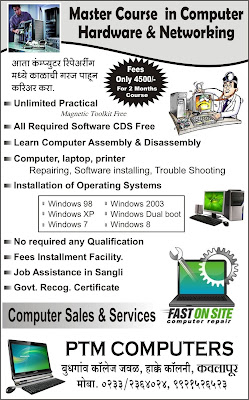Computer Hardware Free Lessons
Lesson 1
1.1 The first use of the word “computer” was recorded in 1613 in a book called “The yong mans gleanings” by English writer Richard Braithwait I haue read the truest computer of Times, and the best Arithmetician that euer breathed, and he reduceth thy dayes into a short number. It referred to a person who carried out calculations, or computations, and the word continued with the same meaning until the middle of the 20th century. From the end of the 19th century the word began to take on its more familiar meaning, a machine that carries out computations.
1.2
Blaise Pascal invented the mechanical calculator in 1642, known as Pascal's calculator, it was the first machine to better human performance of arithmetical computations and would turn out to be the only functional mechanical calculator in the 17th century. Two hundred years later, in 1851, Thomas de Colmar released, after thirty years of development, his simplified arithmometer; it became the first machine to be commercialized because it was strong enough and reliable enough to be used daily in an office environment. The mechanical calculator was at the root of the development of computers in two separate ways. Initially, it was in trying to develop more powerful and more flexible calculators that the computer was first theorized by Charles Babbage and then developed Secondly, development of a low-cost electronic calculator, successor to the mechanical calculator, resulted in the development by Intel of the first commercially available microprocessor integrated circuit.
1.1 The first use of the word “computer” was recorded in 1613 in a book called “The yong mans gleanings” by English writer Richard Braithwait I haue read the truest computer of Times, and the best Arithmetician that euer breathed, and he reduceth thy dayes into a short number. It referred to a person who carried out calculations, or computations, and the word continued with the same meaning until the middle of the 20th century. From the end of the 19th century the word began to take on its more familiar meaning, a machine that carries out computations.
1.2
Limited-function early computers
The history of the modern computer begins with two separate technologies, automated calculation and programmability. However no single device can be identified as the earliest computer, partly because of the inconsistent application of that term. A few devices are worth mentioning though, like some mechanical aids to computing, which were very successful and survived for centuries until the advent of the electronic calculator, like the Sumerian abacus, designed around 2500 BC of which a descendant won a speed competition against a contemporary desk calculating machine in Japan in 1946, the slide rules, invented in the 1620s, which were carried on five Apollo space missions, including to the moon and arguably the astrolabe and the Antikythera mechanism, an ancient astronomical analog computer built by the Greeks around 80 BC. The Greek mathematician Hero of Alexandria (c. 10–70 AD) built a mechanical theater which performed a play lasting 10 minutes and was operated by a complex system of ropes and drums that might be considered to be a means of deciding which parts of the mechanism performed which actions and when. This is the essence of programmability.Blaise Pascal invented the mechanical calculator in 1642, known as Pascal's calculator, it was the first machine to better human performance of arithmetical computations and would turn out to be the only functional mechanical calculator in the 17th century. Two hundred years later, in 1851, Thomas de Colmar released, after thirty years of development, his simplified arithmometer; it became the first machine to be commercialized because it was strong enough and reliable enough to be used daily in an office environment. The mechanical calculator was at the root of the development of computers in two separate ways. Initially, it was in trying to develop more powerful and more flexible calculators that the computer was first theorized by Charles Babbage and then developed Secondly, development of a low-cost electronic calculator, successor to the mechanical calculator, resulted in the development by Intel of the first commercially available microprocessor integrated circuit.


